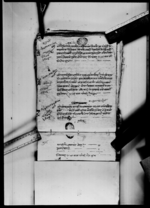A copy of a lālamohara from King Rājendra appointing Tārānātha Arjyāla as caretaker of the guṭhī attached to Gorkha's dasaĩghara (VS 1876)
ID: K_0015_0022B
Edited and
translated by Astrid Zotter
in collaboration with
Pabitra Bajracharya
Created: 2019-09-04;
Last modified: 2023-03-01
For the metadata of the document, click here
The accompanying edition, translation/synopsis and/or commentary are available under the terms of the Creative Commons Attribution-ShareAlike 4.0 International License
Abstract
This copy of a lālamohara from the king, who according to the date must have been Rājendra, appoints Tārānātha Arjyāla as caretaker of a guṭhī of the main deity of the dasaĩghara of Gorkha together with its landholdings at Purkoṭa.Diplomatic edition
[1r]
1पो१४व१२पा९९सी५२३1१९८1प्रोहीत्याई2भंनौहर्ष
3हेनौवासु1आगेतारानाथप्रोहितअर्ज्यालेके∙रणसुरथापाकोखाये़ल्गोर्खादसौघरका∙
2श्री५मुलदेवताकोगुठपुर्कोटथुम∙१षेततस्कोलगापाट∙पाखोरेखोलगाय़त
3स्मेतलालमोहरगरिवक्स्यौंआफ्नाखातिरज्मासंगव़र्षप्रति२४अष्टमी
4विसेषमहाष्टमी∙चैत्राष्टमी∙कोकाजतामापत्र∙लालसव़ालमाभन्या∙
5वमोजींकोकाम्चलाईगुठकोअक्तीआरी∙भै∙गुठचलाईहाम्रोजय़मनाई
6सुषभोग्य़गर१८७६साल∙मार्गवडि२रोज३सुभ¯¯¯ ¯¯¯
Translation
[1r]
[In the left margin:]
Bundle (po[kā]) 14, va 12, pā 99, sī 523 1
1982
[Concerning] a purohityāī̃
The one who said [was] the nau[sindā]Harṣa.3
The one who watched [was] the nausindāBāsu.
Āge: To Tārānātha Prohita Arjyāla
We [herewith] issue a lālamohara and confer [upon you] Raṇasura Thāpā's property holdings (khāyel): the guṭha of the fivefold glorious main deity of Gorkhā's dasaĩghara [consisting of] the 1 thuma of Purkoṭa [including] irrigated land (kheta) together with surrounding land (lagāpāṭa), i.e. a range of hillside land (pākhorekho) and so on. Being mindful of your duties, perform the tasks related to the 24 aṣṭamī days every year, especially those of Mahāṣṭamī and Caitrāṣṭamī, carrying out the work according to what is stated in the copperplate, lāla[mohara]4 and directives (savāla). Operate the guṭha as its caretaker (akhtiyārī), celebrate our triumphs and enjoy [the attendant fruits] happily.
Tuesday,5 the 2nd of the dark fortnight of Mārga in the [Vikrama era] year 1876 (4 November 1819).6 Auspiciousness.
Commentary
The present document has to do with the management of the guṭhī related to the dasaĩghara at Gorkha Palace. This guṭhī was established by the king's grandmother, Kāntavatī Devī, in VS 1856 (1799 CE) and controlled 1,300 murīs of land at Purkoṭa in the district of Tanahu (see K_0120_0020).
The present lālamohara appoints Tārānātha Arjyāla to manage the guṭhī and to function as its akhtiyārī. According to the Sanskrit text of the copperplate (K_0120_0020), where the post is called adhikārī, this person would have to protect the guṭhī land at Purkoṭa and see to it that the items specified in the corresponding dānapatra (reissued in VS 1942 after having become unreadable; see K_0120_0024) were provided from its produce and brought to the dasaĩghara at Gorkha. Furthermore, he would have to inform state authorities in case the items could not for some reason be provided.
The categorization of the copy in the filing ledger as a purohītāī suggests that Tārānātha Arjyāla had also been appointed as the priest. This is not necessarily the case, even if he is called a purohita in the document and his surname Arjyāla points to a family background of royal house-priests.7 His predecessor as akhtiyārī of the guṭhī, however, Raṇasura Thāpā, would unlikely have been a purohita. In the modern assignment of roles serving the deity of the dasaĩghara at Gorkha Palace, the mūlapurohita is a Bhaṭṭarāī Brahmin who comes for this occasion from Kathmandu, while the Arjyālas are involved in the fire sacrifice as hotus and ācāryas (Unbescheid 1996: 107). Ten members from the Thāpā family who are Magars act as bāhiryā susāres, "servants in the outer realm" (ibid.: 108). It is unknown how the ritual tasks were organized at the time the present document was issued and the extent to which the manager of the Purkoṭa Guṭhi, responsible for providing the ritual accessories, also had a say in appointing ritual specialists.
If the Tārānātha Arjyāla appointed in the present document is identical with the person of the same name who later, at least from the late 1830s on, became the royal treasurer (khajāncī) and who remained in this post until 1845,8 the present document would attest to one of the early rungs of his career ladder.

